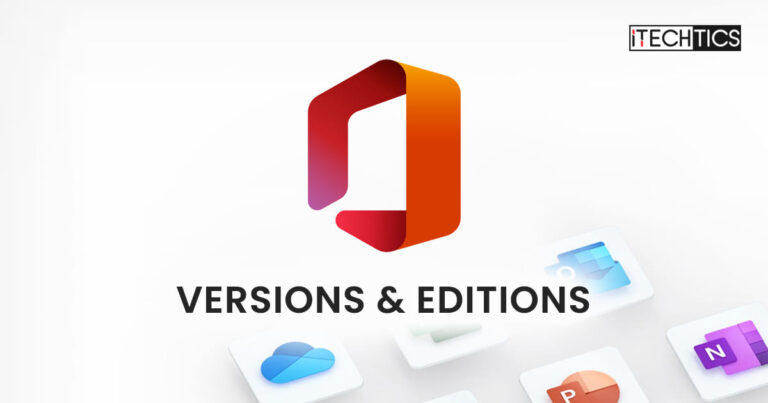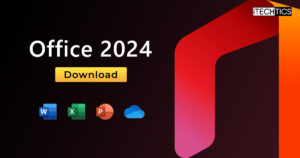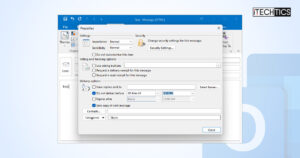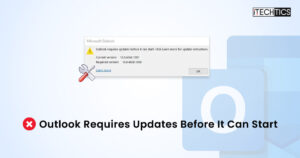Microsoft Office has been the go-to office suite for businesses, students, and home users for decades, providing unparalleled features and tools that help people get work done quickly and efficiently. With its user-friendly interface and wide range of applications, Microsoft Office has become an essential part of our daily lives.
If you are looking for a reliable and versatile office suite that can help you boost your productivity, Microsoft Office is the ultimate choice. But with so many versions and editions available, it can be daunting to choose the right one.
The Microsoft Office suite is offered in both online and offline versions. The online version of Microsoft Office, also known as Office Web Apps, is free to use and can be opened on any platform using a web browser. However, that is not what we will be focusing on today.
The offline versions of Microsoft Office are a suite that includes different Microsoft products, like Word, Excel, etc. and are updated every few years. Another model of Microsoft Office is a subscription-based model included in Microsoft 365. Microsoft 365 is also updated and offers different versions, but they are a little different from the versions which Microsoft Office offline offers.
This article will provide you with a clear understanding of what Microsoft Office versions and editions entail, so you can make the right decision that meets your specific needs. With our expert insights, you will be well on your way to mastering Microsoft Office in no time.
Table of Contents
Microsoft Office Offline vs. Online
As previously mentioned, there is a free-to-use Microsoft Office model known as the Office Web Apps. When talking about the different models for Microsoft Office, the online web apps are standalone products of the Office suite, such as Microsoft Word, Excel, etc., and can be accessed through any web browser and a Microsoft account.
Follow this link to Get Free Microsoft Office Apps Including Word, Excel, PowerPoint.
This model of Microsoft Office can be confused with Microsoft 365 – which is a completely different model of Microsoft Office products.
Microsoft 365 is a subscription-based model of Microsoft products, which includes all new updates to the Office system. It includes both apps and services as well as cloud-based software designed to increase connectivity and productivity in an organization.
Since it is a subscription-based service run by Microsoft, clients are given updates automatically without them having to pay for a new license for each new build of the products. The individual software remains free and updated to the latest version until the subscription is canceled or expires.
In contrast, Microsoft Office offline versions are one-time purchase products that only get updates specific to Office products. The products inside the Office version that you have purchased are updated and their build increases. However, every few years, Microsoft publishes a major update for Microsoft offline version, for which a new license needs to be purchased by the clients.
For example, the offline versions of Microsoft Office include Office 2013, Office 2016, and so on. These are the major updates for offline Office, which are also referred to as “Microsoft Office versions.”
What is Microsoft 365
Microsoft 365 is a revolutionary subscription-based service that surpasses the traditional Microsoft Office suite by offering a range of advanced features and benefits that its predecessors cannot match.
With Microsoft 365, you not only have access to popular Office applications like Word, Excel, PowerPoint, and OneNote but also to an extensive selection of supplementary tools and services that enable you to work smarter, faster, and more efficiently.
Its cloud-based productivity tools enable you to work on projects and collaborate with colleagues in real-time from anywhere, at any time. Additionally, you can access sophisticated artificial intelligence capabilities, such as Microsoft Editor and Microsoft Money in Excel, that help you enhance your writing and financial planning skills.
Besides that, Microsoft 365 also provides a plethora of other intelligent features, including Resume Assistant and Presenter Coach, that assist you in creating impressive resumes and compelling presentations. With OneDrive, Microsoft’s cloud storage service, you can store and share files, making collaboration with coworkers, classmates, or family members seamless.
Below we have mentioned the standard products that Microsoft 365 offers.
| Microsoft 365 Products | Description |
|---|---|
| Word | A word processing application for creating and editing documents. |
| Excel | A spreadsheet program for organizing, analyzing, and visualizing data. |
| PowerPoint | A presentation program for creating and delivering presentations. |
| OneNote | A digital notebook for taking notes, storing information, and sharing ideas. |
| Outlook | An email client and personal information manager for managing email, contacts, and calendars. |
| Publisher | A desktop publishing application for creating professional-looking publications. |
After understanding what Microsoft 365 is, you might wonder where the different versions of Microsoft Office fit in.
Microsoft Office Versions
Microsoft Office is a suite of Microsoft software/products. The recent Office versions are a group of new and improved Microsoft software that are released from time to time. They have updates, new features, and better performance compared to the old versions.
When talking about Microsoft Office versions, we mostly refer to the offline model of Office only – since only the offline models receive major updates. Microsoft Office versions are generally named with a suffix of the year it is released in, or near the following year. For example, these are named “Microsoft Office 2019,” “Microsoft Office 2016,” etc. Office 2019 was released in September 2018, whereas Office 2016 was released in September 2015.
Note that this doesn’t mean that Microsoft 365 doesn’t have versions. The updates released for Microsoft 365 also have versions as well as build numbers. This topic is discussed in detail further down this post.
These versions are used by individuals, businesses, and organizations of all sizes to stay current with the latest technology and features, improve productivity and efficiency, and maintain compatibility with other systems and applications.
In a world where technology is constantly evolving, staying up-to-date with the latest software versions is crucial to remain competitive, efficient, and effective. With each new version, Microsoft strives to provide you with a more seamless and intuitive, making it easier to work, create, and collaborate.
The table below lists the different Microsoft Office versions released over the years.
| Microsoft Office Versions | Release Date | Availability |
|---|---|---|
| Office 95 | August 24, 1995 | Discontinued |
| Office 97 | November 19, 1996 | Discontinued |
| Office 2000 | June 7, 1999 | Discontinued |
| Office XP | May 31, 2001 | Discontinued |
| Office 2003 | August 19, 2003 | Discontinued |
| Office 2007 | January 30, 2007 | Discontinued |
| Office 2010 | June 15, 2010 | Discontinued |
| Office 2013 | January 29, 2013 | Discontinued |
| Office 2016 | September 22, 2015 | Currently Available |
| Office 2019 | September 24, 2018 | Currently Available |
| Office 2021 | October 5, 2021 | Currently Available |
Now, it is important to understand that the different Office versions are not the only variants of Office. Each of these versions then comprises different editions that Microsoft offers.
Microsoft Office Editions
Microsoft editions refer to the combination of tools offered by Microsoft software products that are tailored to your specific needs and preferences.
In the case of Microsoft 365, it offers no editions, but different subscription models. A few common subscription models include the Microsoft 365 Family, Microsoft 365 Personal, Microsoft 365 Home, etc. Each model has different features and functionalities designed to meet the varying requirements of home users, professionals, and students.
On the other hand, the offline versions of Microsoft Office offer different editions, similar to the model of the Windows operating system. Consider Windows 11 for a moment; it is offered in the following editions:
- Professional
- Enterprise
- Home
- Education, etc.
In the same way, Microsoft Office is offered in several editions. Examples of Microsoft Office include Home & Student, Office Professional, etc., which offer different sets of applications and services, such as Word, Excel, PowerPoint, and Outlook, depending on your needs.
The main idea behind Office editions is to provide a range of options that cater to different audiences with different needs, allowing you to choose the right edition that fits your requirements and budget. So, whether you are a home user, a student, a professional, or a business, Office has an edition that is right for you.
Here, we have compiled a table that compares the different Microsoft 365 models and the different editions of the latest version of Microsoft Office offline (Office 2021).
Note that this table does not include all of the subscription-based models for Microsoft 365, nor all of the editions for Office 2021.
| Features | Microsoft 365 Personal | Microsoft 365 Family | Office Home & Business 2021 | Office Home & Student 2021 |
|---|---|---|---|---|
| Purchase Type | Subscription | Subscription | One-time purchase | One-time purchase |
| Cost | $6.99/month or $69.99/year | $9.99/month or $99.99/year | $249.99 | $149.99 |
| Max Number of Users | 1 | Up to 6 | 1 | 1 |
| Max Number of Devices | 5 | Up to 6 | 1 | 1 |
| Compatible Devices | PC, Mac, iPhone, iPad, Android phones, and tablets | PC, Mac, iPhone, iPad, Android phones, and tablets | PC or Mac | PC or Mac |
| Cloud Storage | 1 TB (1000 GB) | 1 TB (1000 GB) | N/A | N/A |
| Offline Access | Yes | Yes | Yes | Yes |
| Products Included | Word, Excel, PowerPoint, OneNote, Outlook, Publisher (PC only), Access (PC only) | Word, Excel, PowerPoint, OneNote, Outlook, Publisher (PC only), Access (PC only) | Word, Excel, PowerPoint, Outlook | Word, Excel, PowerPoint |
| Customizable Templates | Yes | Yes | Yes | Yes |
| Expandable Content Library | Yes | Yes | No | No |
| Microsoft Teams | Yes | Yes | Yes | Yes |
| Purchase Link | Personal | Family | Home & Business | Home & Student |
Compare the latest Microsoft Office editions
Microsoft Office Versions VS. Editions
Version refers to the software version that Microsoft has assigned to a specific software e.g., Office 2016, Office 2019, and Office 2021. Whereas, edition refers to a specific set of features included in each version of Office. Edition is targeted towards different audiences of the same software e.g., Business, Professional, Education, etc.
Versions represent the broader category of the software product, whereas editions are the specific variations within that category.
It is important to note that although Microsoft 365 may not have any versions or editions, it does offer different models. Each model of Microsoft 365 offers a different product range put together to cater to different home and enterprise needs.
With powerful applications and integrated services, Microsoft Office provides a comprehensive productivity solution to help you work smarter, not harder.
Here is a list of all the Office versions released to date and the editions that they offer to help you better understand the differences.
| Microsoft Office Versions | Office Editions |
|---|---|
| Office 95 | Standard, Professional, Developer, Professional Plus |
| Office 97 | Standard, Professional, Small Business Edition, Developer |
| Office 2000 | Standard, Professional, Premium, Developer |
| Office XP | Standard, Professional, Developer |
| Office 2003 | Standard, Professional, Small Business Edition |
| Office 2007 | Home and Student, Standard, Professional, Small Business, Enterprise, Ultimate |
| Office 2010 | Home and Student, Home and Business, Standard, Professional, Professional Plus, Academic, Enterprise |
| Office 2013 | Home and Student, Home and Business, Standard, Professional, Professional Plus |
| Office 2016 | Home and Student, Home and Business, Standard, Professional, Professional Plus, Office 365 Personal, Office 365 Home, Office 365 Business, Office 365 Business Premium, Office 365 Enterprise, Office 365 Education, Office 365 Nonprofit |
| Office 2019 | Home & Student, Home & Business, Standard |
| Office 2021 | Home & Student, Home & Business, Standard |
| Microsoft 365 | Personal, Family, Business Basic, Business Standard, Business Premium, Apps for Enterprise, E5, Education, Education Plus, Nonprofit Business Basic, Nonprofit Business Standard, Nonprofit Business Premium, Nonprofit E3, Nonprofit E5, F1, Government E3, Government E5, Firstline Worker, Business Basic, Business Standard, Business Premium |
Note: Regardless of the version or edition you choose, you must have a valid license from Microsoft to run the programs smoothly. For more information on this, visit: Buy or remove Microsoft 365 licenses for a subscription.
Microsoft 365 Version and Build Number
As mentioned earlier, Microsoft 365 also receives regular updates, gradually increasing its version as well as the build number. The version of Microsoft 365 changes when a major update is published by Microsoft, whereas the build number changes when minor updates are rolled out.
The build number represents the specific version of Microsoft 365 installed on your PC. This number is typically a five-digit number that is updated regularly to reflect bug fixes, security updates, and new features.
Microsoft 365 versions are typically defined using 4 digits, where the first 2 digits represent the year the update was rolled out and the last 2 digits are the month. This makes the version model YYMM. For example, if the version is “2302,” it means that the update was released in February 2023.
Note: Sometimes the version numbers are off by a month. For example, if an update was released on 10th January 2023, it may have version “2212”, depicting that it was released in December 2022 instead. This is common.
The version is then followed by a build number. Microsoft initially used 8 digits to represent the builds. These 8 digits were separated by a period, where the first 4 digits represented the major build release and the second 4 digits represented the minor release. However, in 2018, they shifted to a 10-digit build number, and now the Microsoft 365 builds look something like this: XXXX.XXXX.
the version number is updated less frequently than the build number. Version numbers are often used to describe the overall state of Microsoft 365.
Here is a Microsoft post containing all history of the different Microsoft 365 versions and builds.
Microsoft 365 And Office For Mac
If you are a Mac user and wondering if Microsoft has rolled out any products for you then, you won’t be disappointed. Following are the versions and editions that you can purchase and run on your Mac without any inconvenience.
- Microsoft 365 Family
- Microsoft 365 Personal
- Office Home & Student 2021
- Office Home & Business 2021
- Office Professional 2021
Choosing The Right Microsoft Product
Selecting the appropriate version and edition of a Microsoft product can significantly impact your productivity, security, and overall computing experience. Therefore, it is critical to carefully determine your requirements and choose the most suitable option for optimal performance.
Make sure to understand and follow our step-by-step guide:
-
Decide on a Product
The first thing you need to consider is which model of Microsoft Office you need. This decision will be based on what you intend to use it for.
If you are a student and need it for personal assignments, then maybe the free web version might be sufficient for you. If you work for a company and frequently need to collaborate with your peers, then you may want to opt for a Microsoft 365 subscription.
However, if you need professional work done but mostly find only yourself working on documents and reports, then maybe the offline version of Microsoft Office may be sufficient to satisfy your needs.
-
Consider your Budget
Another thing to consider is what you are willing to spend on the Office product. Are you ready to make a monthly deposit or would you like to make a one-time purchase? Of course, if you are to collaborate with other people on documents, then you will need a Microsoft 365 subscription, and it is not offered as a one-time purchase.
But if you do go for the offline versions of Office, then you should consider the costs for the different editions.
-
Understand the Microsoft Products offered in each edition or subscription model
Once you have decided on the model of Microsoft Office right for you, the next step is to choose the appropriate edition. This will depend on the features you require and the type of user you are.
For example, if you are a home user, you may opt for the “Home and Student” or “Home and Business” editions if you are leaning towards the offline version, while if you are a business user, you may require one of the “Business” or “Enterprise” editions.
The same applies if you are leaning towards a Microsoft 365 subscription – consider the products and services offered in each model.
-
Review the features
It is important to review the features that are included in each edition of Microsoft 365 to ensure that you are getting the functionality you need.
For example, if you need to collaborate with others on documents, you may require the co-authoring feature, which is available in most editions of Microsoft 365.
Final Thoughts
You must understand the distinction between Microsoft models, versions, and editions to make the right choice for your software needs. While versions denote the release timeline of a software product, editions describe the specific products, features, and services included in a particular release.
You must do your research on Microsoft Office before making a purchase. Every version of Microsoft Office comes with different editions. While Microsoft Office 2019 may offer one set of editions, Office 2021 may offer different editions. Look up what each edition has to offer before making a purchase.
Keeping these differences in mind lets you choose the best fit aligned with your computing needs, resulting in a more efficient and enjoyable digital experience.








